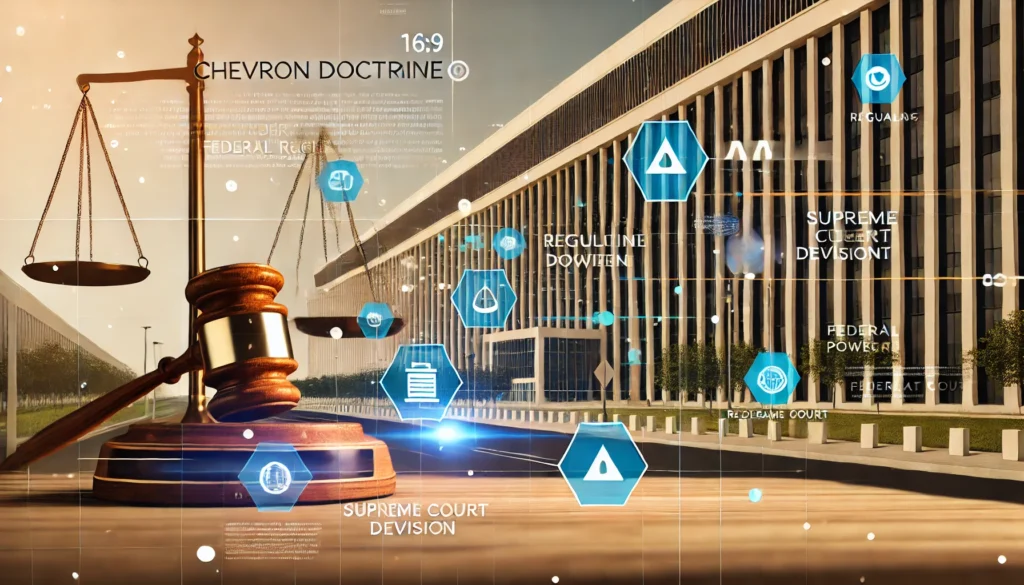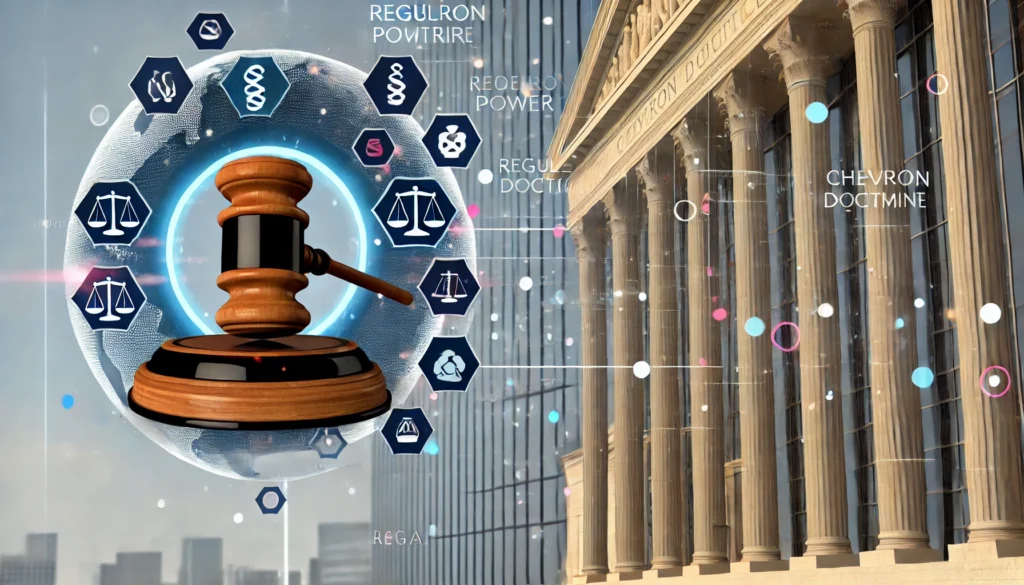The upcoming Supreme Court decision on the Chevron Doctrine Impact has garnered widespread attention from legal experts, policymakers, and businesses alike. This longstanding doctrine has shaped federal regulations by granting agencies interpretive authority over ambiguous laws. Now, as the Court prepares to revisit it, the effects on federal regulations and agency power could be transformative.

What is the Chevron Doctrine?
The Chevron Doctrine originated from the 1984 case Chevron U.S.A., Inc. v. Natural Resources Defense Council, Inc. Over the years, agencies have used Chevron to implement regulations across sectors, including environmental and labor law.
Why is the Chevron Doctrine Under Review?
The Chevron Doctrine has faced criticism for its broad delegation of authority to federal agencies. Critics argue that it gives unelected officials too much control, allowing them to create rules without direct congressional oversight. Recently, some justices have questioned this approach, suggesting a possible shift toward more judicial oversight of agency decisions.
Potential Impacts on Federal Regulations
A decision to limit or overturn the Chevron Doctrine could reshape federal regulations. Here’s how:
- Reduced Agency Power: Agencies like the Environmental Protection Agency (EPA) may lose flexibility in interpreting ambiguous statutes. This change could require Congress to provide clearer legislative language, potentially delaying new regulations.
- Increased Judicial Review: Courts would play a larger role in interpreting federal laws. This shift could lead to stricter interpretations, slowing down the regulatory process.
- With less agency flexibility, businesses might face more rigid compliance requirements.
How Businesses and Agencies Can Prepare
In anticipation of the decision, federal agencies and businesses should take proactive steps. For businesses, staying informed is key. Assessing potential impacts and consulting legal experts can provide valuable guidance.
For some companies, reduced agency power might mean fewer regulations to follow.
Final Thoughts: A Changing Regulatory Landscape
Potential changes to the Chevron Doctrine highlight shifts in U.S. regulatory law. For businesses, agencies, and the public, this shift underscores the need for vigilance and adaptability.
The upcoming decision may reshape how federal regulations are created and enforced. Staying informed and preparing for these changes can help businesses navigate a new regulatory era.
आगामी शेवरॉन सिद्धांत निर्णय का संघीय नियमों पर प्रभाव
शेवरॉन सिद्धांत पर सुप्रीम कोर्ट का आगामी निर्णय कानूनी विशेषज्ञों, नीति निर्माताओं और व्यवसायों के बीच चर्चा का विषय बन गया है। यह सिद्धांत, जो 1980 के दशक से प्रशासनिक कानून का हिस्सा है, संघीय एजेंसियों को अस्पष्ट कानूनों की व्याख्या करने की अनुमति देता है। जैसे ही कोर्ट इस पर पुनर्विचार कर रहा है, इसका संघीय नियमों पर व्यापक प्रभाव पड़ सकता है।

शेवरॉन सिद्धांत क्या है?
Natural Resources Defense Council, Inc. मामले से आया। यह एजेंसियों को अस्पष्ट कानूनों की व्याख्या करने की अनुमति देता है, जब तक वह व्याख्या उचित हो। वर्षों से, एजेंसियों ने इसे पर्यावरण और श्रम कानून जैसे क्षेत्रों में नियम लागू करने के लिए इस्तेमाल किया है। अब, सुप्रीम कोर्ट के पुनर्विचार से एजेंसियों की शक्ति में बदलाव हो सकता है।
शेवरॉन सिद्धांत की समीक्षा क्यों हो रही है?
शेवरॉन सिद्धांत ने एजेंसियों को काफी अधिकार दिया है, जिसके लिए इसे आलोचना का सामना करना पड़ा है। आलोचकों का कहना है कि इससे निर्वाचित अधिकारियों को अत्यधिक नियंत्रण मिल गया है, जिससे वे बिना सीधे कांग्रेस की मंजूरी के नियम बना सकते हैं। हाल के वर्षों में, कुछ जजों ने इस सिद्धांत पर सवाल उठाए हैं, जो न्यायिक समीक्षा को बढ़ाने का संकेत देता है।
संघीय नियमों पर संभावित प्रभाव
यदि सुप्रीम कोर्ट शेवरॉन सिद्धांत को सीमित या निरस्त करता है, तो संघीय नियमों में नाटकीय बदलाव आ सकते हैं। मुख्य प्रभाव कुछ इस प्रकार हैं:
- एजेंसी की शक्ति में कमी: पर्यावरण संरक्षण एजेंसी (EPA) जैसी एजेंसियों को लचीलेपन में कमी हो सकती है। इसके बजाय, कांग्रेस को कानूनों में अधिक स्पष्टता देनी होगी, जिससे नियमों में देरी हो सकती है।
- बढ़ी हुई न्यायिक समीक्षा: अदालतों को संघीय कानूनों की व्याख्या का अधिकार अधिक मिलेगा। इससे नियम प्रक्रिया में मंदी आ सकती है।
- व्यवसाय और नीति पर प्रभाव: स्वास्थ्य देखभाल, वित्त और ऊर्जा जैसे क्षेत्रों में बड़े बदलाव हो सकते हैं। कड़ी समीक्षा के कारण, व्यवसायों को अधिक कठोर अनुपालन मानकों का सामना करना पड़ सकता है।
व्यवसाय और एजेंसियां कैसे तैयारी कर सकती हैं
शेवरॉन सिद्धांत के निर्णय को ध्यान में रखते हुए, एजेंसियों और व्यवसायों को संभावित परिवर्तनों के लिए तैयार रहना चाहिए। एजेंसियों को अपने नियमों में स्पष्टता प्रदान करनी चाहिए। व्यवसायों के लिए, सूचित रहना और कानूनी सलाह लेना आवश्यक है।
कुछ व्यवसायों के लिए, एजेंसी की शक्ति में कमी से नियमों की संख्या घट सकती है। जबकि दूसरों के लिए, कड़ी न्यायिक निगरानी से कड़े मानक आ सकते हैं।
अंतिम विचार: एक बदलता नियामक परिदृश्य
शेवरॉन सिद्धांत में संभावित बदलाव अमेरिकी नियामक कानून में बदलाव को दर्शाते हैं। जैसे ही सुप्रीम कोर्ट इस सिद्धांत को परिभाषित कर रहा है, कांग्रेस, एजेंसियों और अदालतों के बीच संतुलन बदल सकता है।
आगामी निर्णय संघीय नियमों को बदल सकता है। तैयार रहना और इन परिवर्तनों की जानकारी रखना व्यवसायों को नए नियामक युग में सफलता के लिए मदद कर सकता है।
Follow my website for more interesting and insightful blogs!
